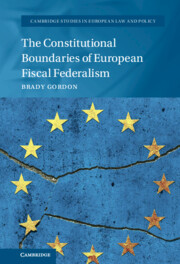Book contents
- The Constitutional Boundaries of European Fiscal Federalism
- Cambridge Studies in European Law and Policy
- The Constitutional Boundaries of European Fiscal Federalism
- Copyright page
- Basic Table of Contents
- Detailed Table of Contents
- Figures
- Acknowledgements
- Table of Cases
- Table of Legislation, Treaties and Conventions
- Abbreviations
- Part I
- Part II
- 5 The Emergent Centralized Architecture of European Fiscal Federalism
- 6 The Constitutional Boundaries of Economic and Monetary Union under EU Law
- 7 The Constitutional Boundaries of Member State Fiscal Sovereignty
- 8 Principles of Fiscal Federalism for the European Union
- Conclusion
- Proposed Directions for Future Research and Reform
- Bibliography
- Index
Conclusion
from Part II
Published online by Cambridge University Press: 07 April 2022
- The Constitutional Boundaries of European Fiscal Federalism
- Cambridge Studies in European Law and Policy
- The Constitutional Boundaries of European Fiscal Federalism
- Copyright page
- Basic Table of Contents
- Detailed Table of Contents
- Figures
- Acknowledgements
- Table of Cases
- Table of Legislation, Treaties and Conventions
- Abbreviations
- Part I
- Part II
- 5 The Emergent Centralized Architecture of European Fiscal Federalism
- 6 The Constitutional Boundaries of Economic and Monetary Union under EU Law
- 7 The Constitutional Boundaries of Member State Fiscal Sovereignty
- 8 Principles of Fiscal Federalism for the European Union
- Conclusion
- Proposed Directions for Future Research and Reform
- Bibliography
- Index
Summary
The book ends with two conclusions: First, Member State fiscal sovereignty is a permanent constitutional constraint upon the application of fiscal federalism theory in the European Union. Second, hard budget constraints and market discipline are indispensable for the guiding principles of price stability and fiscal discipline in a decentralised federation bound by the fiscal sovereignty of its Member States. In sum, the model chosen for European fiscal federalism must preserve the fiscal sovereignty of its constitutional democracies, and it must have market discipline under hard budget constraints. As for the selection of an appropriate model for EU fiscal federalism, this book proposes that three constitutional tests for fiscal sovereignty identified in Chapter 1, and the five determinates of fiscal discipline identified in Chapter 8, provide an intersecting set of criteria for determining which models of fiscal federalism are compatible and implementable within the boundaries of the European legal order.
Keywords
- Type
- Chapter
- Information
- The Constitutional Boundaries of European Fiscal Federalism , pp. 411 - 417Publisher: Cambridge University PressPrint publication year: 2022

